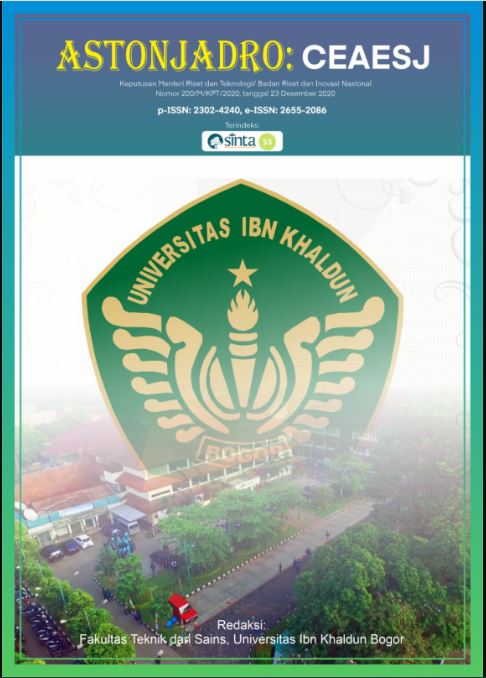IDENTIFICATION OF GREEN ARCHITECTURAL CHARACTERISTICS OF TENGANAN PEGRINGSINGAN VILLAGE, KARANGASEM, BALI
DOI:
https://doi.org/10.32832/astonjadro.v11i2.6770Keywords:
, vernacular architecture, green architecture, tenganan pegringsingan village, energy efficiency, cycles.Abstract
Tenganan Pegringsingan village is one of most Bali Aga villages that located at Karangasem Regency, Bali. This village has a variety of vernacular buildings especially a settlement building. The settlement buildings that is a traditional houses are dwelling that still maintain pattern and shape of the building in the past. In this article will discuss about characteristics of green architecture in vernacular architecture and the genius that applied by people to response the environmental issues. Research using qualitative descriptive method by collecting data through field observations on vernacular building objects followed by a drawing of the object. The result of this research show that there four characteristics of green architecture on vernacular buildings at Tenganan village including aspects of land use, energy efficiency, water conservation, and cycles and material sources.
References
Agusintadewi, N. K. (2017). Pola Spasial Permukiman Tradisional Bali Aga di Desa Sekardadi, Kintamani. Jurnal RUAS, 14(2), 47-57.
Annisa, L. D., Suprapti, A., & Pandelaki, E. E. (2020). Tipologi Rumah Vernakular Berdasarkan Sistem Fisik di Kampung Bandar Pekanbaru, Riau. Jurnal Arsitektur ARCADE, 4(3), 285-291.
Aritama, A. A. N., & Putra, I. D. G. A. D. (2021). Tourism Activities in the Traditional Balinese House: The Challenges of Designing a Homestay in Gianyar Bali. Journal of Social and Political Sciences, 4(1).
Aritama, A. A. N., & Wiryawan, I. W. (2020). Identifikasi Bentuk dan Karakteristik Rumah Tradisional Desa Bungaya, Karangasem, Bali. Undagi: Jurnal Ilmiah Jurusan Arsitektur Universitas Warmadewa, 8(2), 65-71.
Eiseman, F. B. (2011). Bali: Sekala & Niskala: Essays on Religion, Ritual, and Art. California: Tuttle Publishing.
El Shabir, F. H. (2014). Kajian Konsep Arsitektur Hijau Kampung Naga, Jawa Barat. Tesis Tidak Diterbitkan. Bogor: Fakultas Agrikultur IPB Bogor.
Fachrudin, H., & Zafira, K. (2021). Green Architecture Approach in Waste Management Building Design Concept. Makalah disajikan dalam seminar IOP Conference Series: Materials Science and Engineering.
Gelebet, I. N. (1985). Arsitektur Tradisional Bali. Denpasar: Departemen Pendidikan dan Kebudayaan.
Kumurur, V., & Damayanti, S. (2012). Pola Perumahan dan Pemukiman Desa Tenganan Bali. Sabua: Jurnal Lingkungan Binaan dan Arsitektur, 3(2).
Lozanovska, M. (2002). Architectural Frontier/Spatial Story: The Problematic of Representing the Everyday. Journal Space Culture, 5(2), 140-151.
Mentayani, I., & Muthia, P. (2012). Menggali Makna Arsitektur Vernakular: Ranah, Unsur, dan Aspek-Aspek Vernakularitas. LANTING Journal of Architecture, 1(2), 68-82.
Mutaliyev, Ð., Samoilov, K., & Priemets, O. J. (2021). The Interpretation of the Principles of" Green Architecture" in The Concept of Transregional Mono-Stylism Company "Skidmore, Owings and Merrill”. Vestnik Kaznrtu, 143(1), 205-216.
Norouzi, N., Fani, M., & Nasiri, Z. (2021). The Development of a Nexus Based Green Architecture Ranking System in Iran. Civil Engineering Beyond Limits, 2(2).
Putra, I. D. G. A. D., Lozanovska, M., & Fuller, R. (2019). From Spiritualistic Toward More Pragmatic Pattern: Re-ordering Balinese Houses and Viability of The Household Traditions in Tourism Economy. Journal of Architecture Urbanism, 43(1), 47-61.
Putra, P. G. P., & Nugroho, S. (2018). Strategi Pelibatan Generasi Muda dalam Pengelolaan Pariwisata di Desa Tenganan Pegringsingan, Kecamatan Manggis, Kabupaten Karangasem. Jurnal Destinasi Pariwisata, (2), 211-219.
Rajendra, A. (2021). Contemporary Challenges of the Indonesian Vernacular Architecture in Responding to Climate Change. Makalah disajikan dalam seminar IOP Conference Series: Earth and Environmental Science.
Rapoport, A. (1969). House Form and Culture. Englewood Cliffs: Pearson.
Rudofsky, B. (1987). Architecture without Architects: A Short Introduction to Non-Pedigreed Architecture. Albuquerque: UNM Press.
Runa, I. W. (2018). Arsitektur Publik Bali Kuno & Sistem Spasial Desa Pegunungan. Denpasar: Udayana University Press.
Satar, A. E., Syarif, E., & Nadjmi, N. (2018). Arsitektur Vernakular di Sulawesi Selatan dan Perannya terhadap Arsitektur Hijau. Makalah disajikan dalam Seminar IPLBI, Makassar.
Soemardi, W. I., & Ervianto, B. W. (2012). Kajian Reuse Material Bangunan dalam Konsep Sustainable Construction di Indonesia. Jurnal Teknik Sipil UAJY, 12(1), 141.
Swanendri, N. M., & Susanta, I. N. (2018). Transformasi Permukiman Bali Aga di Desa Pakraman Timbrah Kabupaten Karangasem. Jurnal SPACE, 5(2).
Wastika, D. N. (2005). Penerapan Konsep Tri Hita Karana dalam Perencanaan Perumahan di Bali. Jurnal Permukiman Natah, 3(2), 62-105.
Downloads
Published
How to Cite
Issue
Section
License
Paper submitted to ASTONJADRO is the sole property of the Astonjadro Journal. Unless the author withdraws the paper because he does not want to be published in this journal. The publication rights are in the journal Astonjadro.ASTONJADRO
LICENSE
This work is licensed under a Creative Commons Attribution-ShareAlike 4.0 International License.
Based on a work at http://ejournal.uika-bogor.ac.id/index.php/ASTONJADRO













